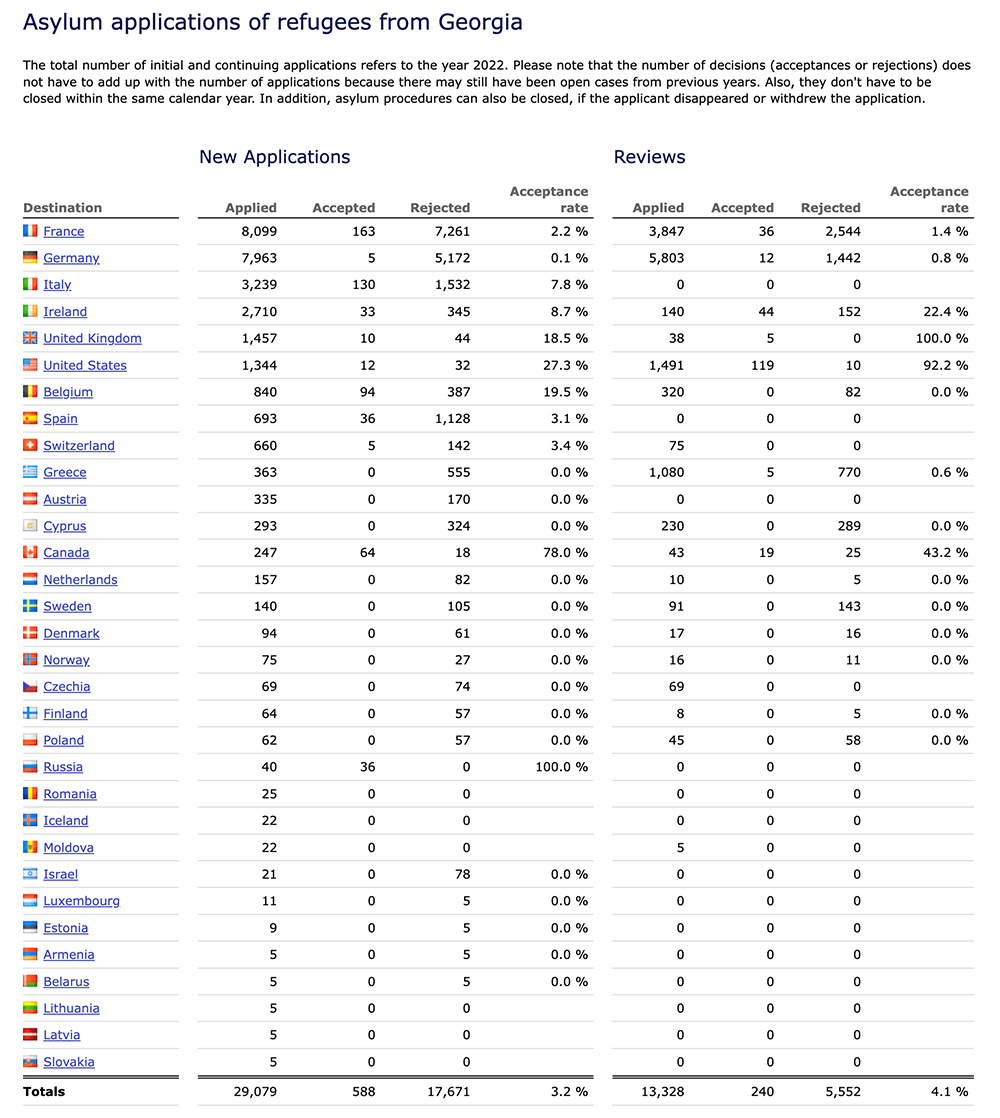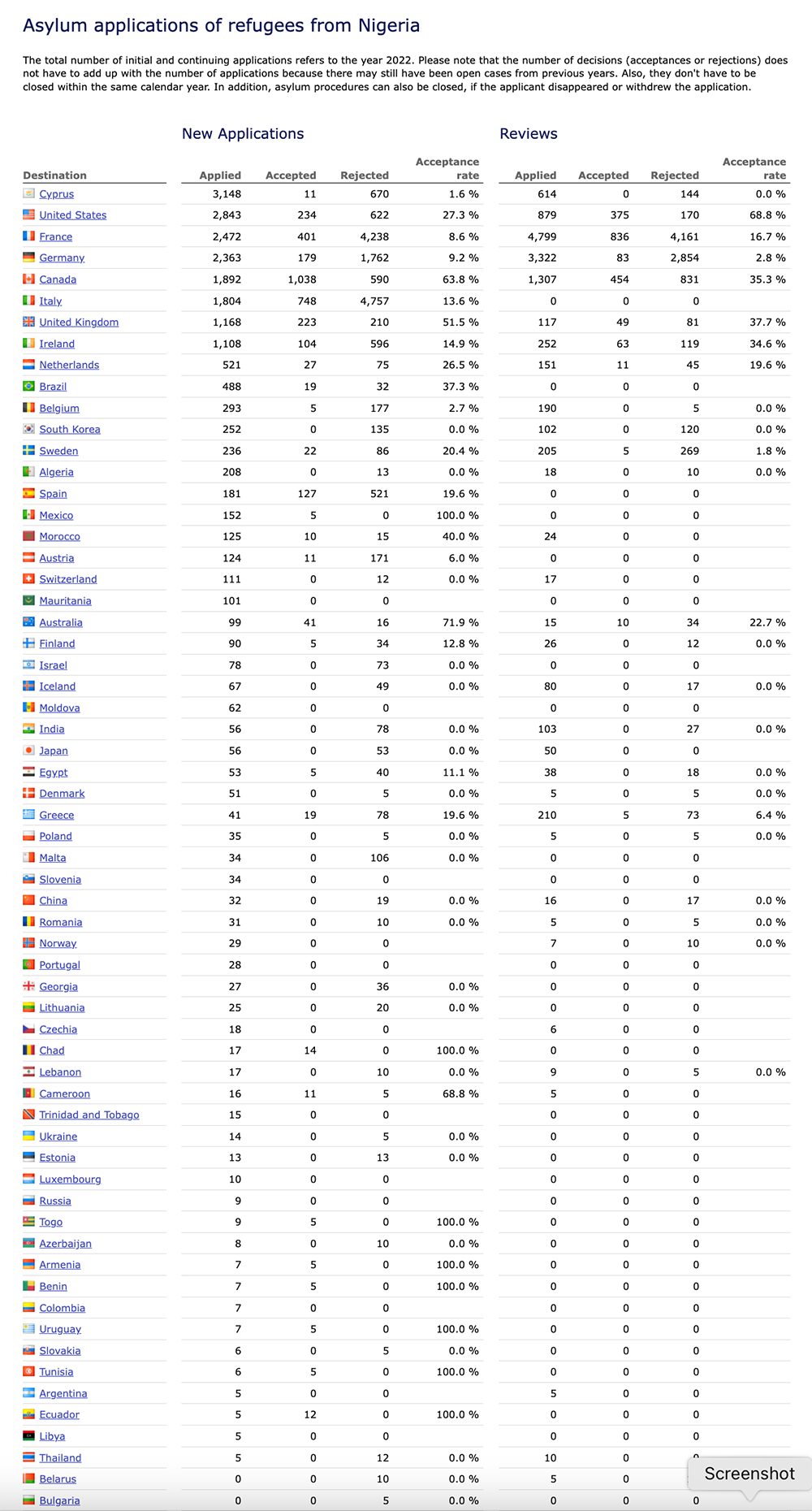As we have pointed out previously the Irish state differs radically from other EU states in the profile of the countries of origin of persons claiming international protection here.
That can be seen by comparing the numbers making applications here to the overall statistics for the EU.
Top 15 nationalities of first time asylum applicants (2022)
That graph shows Syrian, Afghan and Venezuelan migrants heading up the list of applicant numbers across the EU.
In contrast, IPAS figures show that Nigerians (who don’t even feature in the EU’s top 15) make up, by far, the largest number of asylum claims in recent weeks in this country.
There are no geographical, historical, economic or other reasons to explain why Ireland ought to be chosen destination of people from countries which feature in much smaller numbers in other EU states. That has also been the case with regard to the much higher per capita numbers of Ukrainians coming to Ireland.
The state itself has begun to recognise this by introducing changes to welfare provision in the case of Ukrainians applying for Temporary Protection.
It has also extended the list of countries of safe origin. Whether this crackdown on opportunistic economic migration and welfare tourism will be successful remains to be seen.
It is apparent from the official statistics on applications that a distinction has always been made between persons fleeing actual wars and other serious crises – Syria being been main example prior to the Russian invasion of Ukraine – and other countries which clearly have no such situations.
That can be seen in the rates of acceptance of applications from countries which account for a large proportion of both applicants and persons living in accommodation provided by IPAS.
As the official figures show, these have been Georgia, Algeria, Nigeria, South Africa, Zimbabwe and more recently Botswana.
What the statistics on acceptance of applications from those countries show is not that the state has ever been persuaded by the validity of those applications, but that it has failed to respond to that by failing to remove what are effectively bogus asylum applicants from the state.
\This process has admittedly not been helped by the fact that the appeals and reviews process here has been extremely drawn out. The low numbers of deportation orders issued compounded by the low number of orders out into effect compounds all of that.
The most recent statistics we have for international comparative purposes are from 2022. They show that of 29,079 initial applications by persons claiming International Protection from Georgia that just 588 or 3.2% were accepted.
https://www.worlddata.info/asia/georgia/asylum.php

https://www.worlddata.info/asia/georgia/asylum.php
Ireland stands out for a number of reasons. Firstly, that more than 9% of the entire number of applications for asylum in the entire world made by persons claiming to be Georgia were made in Ireland.
Only France, Germany and Italy received more, and it compares to just 40 in Russia. While just 1.4% of reviews in France were successful and less than 1% in Germany, 22.4% of application reviews in Ireland ended in success for the applicant. The global figure was 4%.
According to the most recent statistics from IPAS there were 4,333 people from Nigeria in accommodation provided by them.
That is now the largest of any nationality being accommodated, and reflects the surge in numbers arriving here from that country in recent times.
Nigeria now accounts by far the greatest number of arrivals claiming asylum, having supplanted Georgia and Algeria.
It is likely therefore that the number of applications this year will be greater than in 2022 when Ireland accounted for 1,108 or 5.3% of international applications by Nigerians. The global rate of acceptance was just 17.7% and even lower than that here at 14.9%.
Ireland, however, again stood out when it came to rejections being overturned on review. The overall success rate was 17.3% for Nigerian asylum applications – but was twice that in Ireland here at 35%.

https://www.worlddata.info/africa/nigeria/asylum.php
Algeria has now been added to the Irish list of safe countries of origin and that has been reflected in the sharp fall in arrivals. That decline contradicts the claims of those who were questioning the commonly held belief – including within the state agencies – that migration from Algeria was driven by other factors than any accepted human rights criteria.
MORE ALGERIAN APPLICANTS THAN FRANCE
In 2022, Ireland received 1,766 or 18% of worldwide applications from persons applying for International Protection from Algeria. That made the Irish state the most popular destination in the world, ahead even of France with its long standing historical relationship with its former colony.
Ireland rejected 88.5% of initial applications, slightly higher than the international average; and only accepted 17% of appeals on review. The fact that there are more than 3,000 Algerians in IPAS accommodation is an illustration of the weak follow on from those rejections.
It points to another key flaw in the asylum system, along with our out of kilter acceptance rates, – even when asylum applications are rejected, people are not deported.
In 2022, Ireland also topped the global table in applications from persons claiming asylum from South Africa. There were 450 such applications, 41% of all claims made by South Africans throughout the world and more than every other European country combined.
The closest to the Irish level of applications was the UK with 50, France 30, while just 21 in Germany. The Irish state rejected 95% of initial applications, but accepted 21.6% of reviews, compared to 14% internationally.
Zimbabwe has consistently been among the top countries of origin for International Protection applicants and there are currently more than 2000 Zimbabweans in IPAS accommodation.
In 2022, Ireland took in 973 Zimbabwean asylum seekers, once again the highest number in the world, and 45% of the total global figure. 30% of applications were accepted initially and more than 61% of reviews were successful.
Despite the current claim by the Government that it is addressing abuses of the asylum system, recent evidence would suggest that there has been little substance to actual efforts to crack down on what the state itself clearly recognises as opportunistic migration for purposes that have nothing to do with war or persecution,
As Gript’s analysis of the recent surge in numbers arriving shows – which again contradicts the official narrative – where one hole appears to be plugged, another opens.
Indeed, the proven level of undocumented arrivals and persons who just turn up in Dublin at the International Protection Office illustrate that even the identity and country of origin of such applicants cannot be accepted on face value.
Then, when most such applications are proven to be without valid basis the applicants themselves mostly stay anyway it seems.